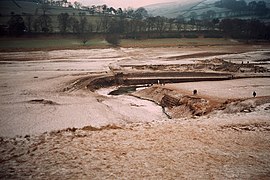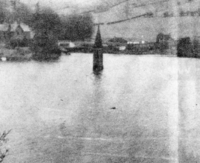Derwent, Derbyshire

Derwent was a village in northernmost Derbyshire, until it was evacuated in 1943 for the construction of the Ladybower Reservoir, under whose waters its remains now lie. The war had delayed construction work, but Derwent and its neighbour Ashopton, which had been evacuated in 1939, were eventually demolished in 1943 as the reservoir was completed.
As the village was drowned, with it went Derwent Woodlands church and Derwent Hall.
There is no formal memorial to any of the villages. However, the site of the construction workers' temporary village when the higher Derwent and Howden Reservoirs were built is clearly marked by a plaque. The only marker of the location of Derwent is the village's War Memorial which stands above Ladybower Reservoir at a point to the west of the village.
The most significant surviving reminder of Derwent Village is the village's packhorse bridge, painted in 1925 by the artist Stanley Royle.[1] This originally spanned the River Derwent near the main gates of Derwent Hall, and was removed stone by stone as it had been designated a monument of national importance. The bridge was transported and rebuilt at the head of Howden Reservoir at Slippery Stones where it now forms part of the paths and cycle tracks around the Derwent Valley reservoirs.
The loss of the village

The church held its last service on 17 March 1943.[2] The bell from the church may still be heard though as it was re-hung elsewhere in the county; in St Philip's Church in Chaddesden, built in 1955.
Bodies from the graveyard had been exhumed in 1940 and were reburied in the village of Bamford.[3]
The population were largely resettled in Yorkshire Bridge, a hamlet further south, and which is now below the dam of the Ladybower Reservoir. All buildings in the village had been demolished by autumn 1943, and the impounded waters of the reservoir began to rise by the end of 1944. The church spire was left intact to form a memorial to Derwent. However, it was dynamited on 15 December 1947, on the excuse of safety concerns. The site of the village has been revealed when the reservoir levels fell dramatically in 1976, 1989, 1996 and 2003.
Today
Despite being flooded, a few houses survive above the waterline, and there remains a civil parish of Derwent. At the time of the 2001 UK census, it had a population of 51. At the 2011 Census the population remained less than 100.
The Derwent Valley Museum, also known as the Dambusters Museum, is housed in a tower on the Derwent Reservoir dam, and run privately by Vic Hallam. It tells the history of the Derwent valley and of Derwent and Ashopton as well as the tale of RAF Squadron 617 ("The Dam Busters") and its training for Operation Chastise during the Second World War.[4][5]
See also
Outside links
| ("Wikimedia Commons" has material about Derbyshire Derwent, Derbyshire) |
- Location map: 53°22’48"N, 1°43’12"W
- Peeping Tom statue moved from Derwent Hall to Castleton Hall YHA
References
- ↑ "Packhorse Bridge, Derwent, Derbyshire". Art Uk. http://artuk.org/discover/artworks/packhorse-bridge-derwent-derbyshire-72281. Retrieved 25 June 2016.
- ↑ Hallam, Vic: 'Silent Valley: The Story of the lost Derbyshire villages of Derwent and Ashopton' (Sheaf Publishing, 1989) ISBN 0-9505458-9-9
- ↑ Old Postcards of Derwent
- ↑ Dambusters.org: The Derwent Valley Museum
- ↑ Peak District View: The Dambusters Museum
